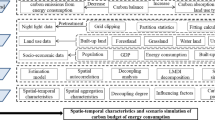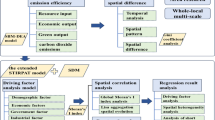Abstract
Global climate continues to warm; by reducing carbon emission (CE) to cope with climate warming has become a global consensus. The influencing factors of CE exhibit diversification and spatial characteristics, and the complexity of the CE system poses challenges to green and low-carbon development and the realization of China’s dual-carbon goals. Taking the Pearl River Delta urban agglomeration as an example, this study explored the influencing factors of CE and designed emission reduction schemes with the help of multi-scale geographically weighted regression (MGWR). Based on this, the system dynamics model was used to construct a CE system framework considering multi-dimensional driving factors, so as to combine the complex CE system with the emission reduction countermeasures considering spatial heterogeneity, and realize the dynamic simulation of CE reduction policies. The results showed that the urban agglomeration as a whole will reach carbon peak by 2025. Shenzhen, Zhuhai, and Dongguan have achieved carbon peak before 2020, while other cities will reach carbon peak by 2025–2030. The government policy constraints can effectively curb CE, but if government constraints were relaxed, CE will rise and individual cities will not reach carbon peak. Comprehensive CE reduction policies are better than a single CE reduction policy. The study found that this model framework provides a systematic analysis of carbon reduction strategies for urban agglomerations, offering decision-makers various combinations of economic development and green low-carbon objectives. This will further contribute to a multi-faceted mitigation of high emission in urban agglomeration and promote regional sustainable development.






Similar content being viewed by others
References
Anser MK (2019) Impact of energy consumption and human activities on carbon emissions in Pakistan: application of STIRPAT model. Environ Sci Pollut Res 26:13453–13463. https://doi.org/10.1007/s11356-019-04859-y
Bel G, Joseph S (2017) Climate change mitigation and the role of technological change: impact on selected headline targets of Europe’s 2020 climate and energy package. Renew Sustain Energy Rev 82:3798–3807. https://doi.org/10.1016/j.rser.2017.10.090
Cui L, Ding Y, Li X (2022) Environmental regulation competition and carbon emissions. Int J Environ Res Public Health 20(1):736. https://doi.org/10.3390/ijerph20010736
Daud A, Jiang W, Arsalan T (2022) Environmental stewardship: analyzing the dynamic impact of renewable energy, foreign remittances, and globalization index on China’s CO2 emissions. Renew Energy 201:418–425. https://doi.org/10.1016/j.renene.2022.10.113
Ding L, Zhang K, Yang Y (2022) Carbon emission intensity and biased technical change in China’s different regions: a novel multidimensional decomposition approach. Environ Sci Pollut Res 29:38083–38096. https://doi.org/10.1007/s11356-021-18098-7
Fotheringham AS, Yang W, Kang W (2017) Multiscale geographically weighted regression (MGWR). Ann Am Assoc Geogr 6:1247–1265. https://doi.org/10.1080/24694452.2017.1352480
Gu R, Li C, Li D, Yang Y, Gu S (2022) The impact of rationalization and upgrading of industrial structure on carbon emissions in the Beijing-Tianjin-Hebei urban agglomeration. Int J Environ Res Public Health 19(13):7997. https://doi.org/10.3390/ijerph19137997
Han N, Luo XY (2022) Carbon emission peak prediction and reduction potential in Beijing-Tianjin-Hebei region from the perspective of multiple scenarios. J Nat Resour 37(5):1277–1288. https://doi.org/10.31497/zrzyxb.20220512
Huang H, Wu X, Cheng X (2021) The prediction of carbon emission information in Yangtze River Economic Zone by deep learning. Land 10(12):1380. https://doi.org/10.3390/land10121380
Jiao L, Yang R, Chen B, Zhang Y (2023) Variation, determinants and prediction of carbon emissions in Guizhou. a new economic growth pole in southwest China. J Clean Prod 417:138049. https://doi.org/10.1016/j.jclepro.2023.138049
Li Z, Fotheringham AS (2020) Computational improvements to multi-scale geographically weighted regression. Int J Geogr Inf Sci 34:1378–1397. https://doi.org/10.1080/13658816.2020.1720692
Li G, Chen X, You X (2023) System dynamics prediction and development path optimization of regional carbon emissions: A case study of Tianjin. Renew Sustain Energy Rev 184:113579. https://doi.org/10.1016/j.rser.2023.113579
Lin S, Wang J (2021) Carbon emission reduction effect of transportation structure adjustment in China: an approach on multi-objective optimization model. Environ Sci Pollut Res 29:6166–6183. https://doi.org/10.1007/s11356-021-16108-2
Liu X, Ou J, Chen Y, Wang S, Li X, Jiao L, Liu Y (2019) Scenario simulation of urban energy-related CO2 emissions by coupling the socioeconomic factors and spatial structures. Appl Energy 238:1163–1178. https://doi.org/10.1016/j.apenergy.2019.01.173
Liu F, Zhang C, Zhang Y, Liu H (2022) A data-driven approach for the measurement and improvement of regional industrial ecological efficiency for carbon peaking and carbon neutralization. Environ Sci Pollut Res 30:7655–7670. https://doi.org/10.1007/s11356-022-22699-1
Liu Z, Deng Z, Davis SJ, Giron C, Ciais P (2022b) Monitoring global carbon emissions in 2021. Nat Rev Earth Environ 3:217–219. https://doi.org/10.1038/s43017-022-00285-w
Liu P, Qin Y, Luo Y, Xinxin W, Xiangwei G (2023) Structure of low-carbon economy spatial correlation network in urban agglomeration. J Clean Prod 394:136359. https://doi.org/10.1016/j.jclepro.2023.136359
Long Z, Zhang Z, Liang S, Chen X, Ding B, Wang B, Chen Y, Sun Y, Li S, Yang T (2021) Spatially explicit carbon emissions at the county scale. Resources. Conserv Recycl 173:105706. https://doi.org/10.1016/j.resconrec.2021.105706
Luo H, Li Y, Gao X, Xiangzhao M, Xiaohu Y, Jinyue Y (2023) Carbon emission prediction model of prefecture-level administrative region: a land-use-based case study of Xi’an city. China Appl Energ 348:121488. https://doi.org/10.1016/j.apenergy.2023.121488
Ma H, Sun W, Wang S, Kang L (2019) Structural contribution and scenario simulation of highway passenger transit carbon emissions in the Beijing-Tianjin-Hebei metropolitan region, China. Resour Conserv Recycl 140:209–215. https://doi.org/10.1016/j.resconrec.2018.09.028
Mao X, Wang Y (2021) Cooperative carbon emission reduction through the Belt and Road Initiative. Environ Sci Pollut Res 29:10005–10026. https://doi.org/10.1007/s11356-021-16130-4
Nocera S, Ruiz-Alarcón-Quintero C, Cavallaro F (2018) Assessing carbon emissions from road transport through traffic flow estimators. Transp Res Part c: Emerg Technol 95:125–148. https://doi.org/10.1016/j.trc.2018.07.020
Peng C, Li B, Nan B (2021) An analysis framework for the ecological security of urban agglomeration: a case study of the Beijing-Tianjin-Hebei urban agglomeration. J Clean Prod 315:128111. https://doi.org/10.1016/j.jclepro.2021.128111
Qiao Z, Meng X, Wu L (2021) Forecasting carbon dioxide emissions in APEC member countries by a new cumulative grey model. Ecol Indic 125:107593. https://doi.org/10.1016/j.ecolind.2021.107593
RajabiKouyakhi N (2022) CO2 emissions in the Middle East: decoupling and decomposition analysis of carbon emissions, and projection of its future trajectory. Sci Total Environ 845:157182. https://doi.org/10.1016/j.scitotenv.2022.157182
Ray RL, Singh VP, Singh SK, Acharya BS, He Y (2021) What is the impact of COVID-19 pandemic on global carbon emissions? Sci Total Environ 816:151503. https://doi.org/10.1016/j.scitotenv.2021.151503
Slameršak A, Kallis G, O’Neill DW (2022) Energy requirements and carbon emissions for a low-carbon energy transition. Nat Commun 13:6932. https://doi.org/10.1038/s41467-022-33976-5
Strapasson A, Woods J, Pérez-Cirera V, Elizondo A, Cruz-Cano D, Pestiaux J, Cornet M, Chaturvedi R (2020) Modelling carbon mitigation pathways by 2050: insights from the Global Calculator. Energ Strateg Rev 29:100494. https://doi.org/10.1016/j.esr.2020.100494
Wang T, Li H (2023) Have regional coordinated development policies promoted urban carbon emission efficiency?—the evidence from the urban agglomerations in the middle reaches of the Yangtze River. Environ Sci Pollut Res 30:39618–39636. https://doi.org/10.1007/s11356-022-24915-4
Wang S, Mo H, Fang C (2021) Carbon emissions dynamic simulation and its peak of cities in the Pearl River Delta Urban Agglomeration. Chin Sci Bull 7:670–684. https://doi.org/10.1360/tb-2021-0681
Wang X, Zhang Y, Li Y (2022) How does the metabolic network change as cities turn into urban agglomerations? A case study of the Beijing-Tianjin-Hebei Region. J Clean Prod 361:132152. https://doi.org/10.1016/j.jclepro.2022.132152
Wei Z, Wei K, Liu J, Yizhuang Z (2023) The relationship between agricultural and animal husbandry economic development and carbon emissions in Henan Province, the analysis of factors affecting carbon emissions, and carbon emissions prediction. Mar Pollut Bullet 193:115134. https://doi.org/10.1016/j.marpolbul.2023.115134
Wen L, Zhang Y (2020) A study on carbon transfer and carbon emission critical paths in China: I-O analysis with multidimensional analytical framework. Environ Sci Pollut Res 27:9733–9974. https://doi.org/10.1007/s11356-019-07549-x
Wright E, Kanudia A (2016) Variation in outcomes and leakage potential across Clean Power Plan compliance designs. Energ Econ 60:438–450. https://doi.org/10.1016/j.eneco.2016.06.016
Wu CB, Huang GH, Xin BG, Chen JK (2017) Scenario analysis of carbon emissions’ anti-driving effect on Qingdao’s energy structure adjustment with an optimization model, Part I: Carbon emissions peak value prediction. J Clean Prod 172:466–474. https://doi.org/10.1016/j.jclepro.2017.10.216
Wu X, Xu C, Ma T, Xu J, Zhang C (2022) Carbon emission of China’s power industry: driving factors and emission reduction path. Environ Sci Pollut Res 29:78345–78360. https://doi.org/10.1007/s11356-022-21297-5
Yu Z, Fan Y, Luo H (2022) Research on the influence of industrial structure upgrading on carbon emission intensity in China. East China Econ Manag 36(1):78–87. https://doi.org/10.19629/j.cnki.34-1014/f.210630001
Zhang L, Ma L (2020) The relationship between industrial structure and carbon intensity at different stages of economic development: an analysis based on a dynamic threshold panel model. Environ Sci Pollut Res 27:33321–33338. https://doi.org/10.1007/s11356-020-09485-7
Zhang D, Wang Z, Li S, Zhang H (2021) Impact of land urbanization on carbon emissions in urban agglomerations of the middle reaches of the Yangtze River. Int J Environ Res Public Health 18(4):1403. https://doi.org/10.3390/ijerph18041403
Zhang B, Yin J, Jiang H, Qiu Y (2022a) Spatial-temporal pattern evolution and influencing factors of coupled coordination between carbon emission and economic development along the Pearl River Basin in China. Environ Sci Pollut Res 30:6875–6890. https://doi.org/10.1007/s11356-022-22685-7
Zhang Y, Yu Z, Zhang J (2022b) Research on carbon emission differences decomposition and spatial heterogeneity pattern of China’s eight economic regions. Environ Sci Pollut Res 29:29976–29992. https://doi.org/10.1007/s11356-021-17935-z
Zhao K, Cui X, Zhou Z, Huang P (2021) Impact of uncertainty on regional carbon peak paths: an analysis based on carbon emissions accounting, modeling, and driving factors. Environ Sci Pollut Res 29:17544–17560. https://doi.org/10.1007/s11356-021-16966-w
Acknowledgements
We thank the editors and the anonymous reviewers for their valuable comments and suggestions.
Funding
This study was supported by the Guizhou Provincial Science and Technology Projects (ZK[2022] normal 030) and the Innovative Exploration and New Academic Seedling Project of Guizhou University of Finance and Economics (2022XSXMB02).
Author information
Authors and Affiliations
Contributions
All authors contributed to the study conception and design. Conceptualization, Jian Yin; methodology, Jian Yin and Yi Ding; validation, Jian Yin, Yi Ding, and Hongtao Jiang; formal analysis, Yi Ding; investigation, Jian Yin; resources, Ruici Xia and Bin Zhang; data curation, Yi Ding; writing original draft preparation, Yi Ding; writing review and editing, Jian Yin and Danqi Wei; visualization, Jian Yin and Xinyuan Luo. All authors read and approved the final manuscript.
Corresponding author
Ethics declarations
Ethical approval
The work does not involve any hazards, such as the use of animal or human subjects’ issue.
Consent to participate
All of the authors of the paper have participated in certain substantive aspects of this study, and they are acknowledged or listed as contributors.
Consent for publication
The paper has not been and will not be submitted simultaneously to other journals. We consent to publish.
Conflict of interest
The authors declare no competing interests.
Additional information
Responsible Editor: V.V.S.S. Sarma
Publisher's Note
Springer Nature remains neutral with regard to jurisdictional claims in published maps and institutional affiliations.
Rights and permissions
Springer Nature or its licensor (e.g. a society or other partner) holds exclusive rights to this article under a publishing agreement with the author(s) or other rightsholder(s); author self-archiving of the accepted manuscript version of this article is solely governed by the terms of such publishing agreement and applicable law.
About this article
Cite this article
Ding, Y., Yin, J., Jiang, H. et al. Dynamic simulation of carbon emission under different policy scenarios in Pearl River Delta urban agglomeration, China. Environ Sci Pollut Res 30, 102402–102417 (2023). https://doi.org/10.1007/s11356-023-29612-4
Received:
Accepted:
Published:
Issue Date:
DOI: https://doi.org/10.1007/s11356-023-29612-4




